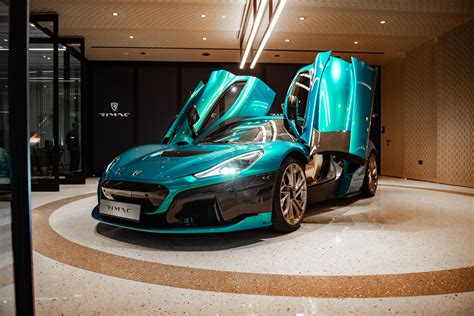Since electric vehicles are clearly the way of the future for the automotive industry, performance cars will inevitably follow suit. Mate Rimac had an early vision for this, and 15 years ago, as a vehicle enthusiast, he founded an automobile firm with the same name with the goal of creating high-tech electric supercars with performance never seen before.
For $2.4 million, Rimac’s new electric vehicle, the Nevera, does more than just look good and travel really fast. It offers the things that a billionaire could brag about and thrives at the forefront of automobile technology. Everywhere you turn, you see cutting-edge technology, from customizable aerodynamics to a carbon monocoque inspired by race cars to the next-generation electric torque vectoring. Let’s dive into the wonder of this remarkable hypercar.

Power, performance and fuel efficiency
When you’re dealing with a car boasting nearly double the horsepower of a Formula 1 vehicle, it’s clear that outright electric range isn’t the top priority. That incredible performance comes with trade-offs, as evidenced by the Nevera’s 204-mile EPA-rated range. Of course, how quickly that figure plummets during a few seconds at the car’s blistering 258-mph top speed—well, that’s a discovery reserved for its wealthy owners. Powering this beast is a massive 117.0-kWh battery pack (or 108 kWh for the Nevera R), ingeniously integrated between and behind the seats, extending underfoot to maximize space and balance. According to the EPA, the Nevera achieves 53, 53, and 54 MPGe ratings for its respective combined, city, and highway estimated values.
Interior
Although the primary goal of the Nevera is performance, Rimac wanted the experience of sitting in one to be as thrilling as the thrill of driving one.

The carbon monocoque from which the complete automobile is fashioned is unavoidable, though the Nevera Rimac can be specially constructed with different materials, colors, and stitching to accommodate any luxurious style. The center fascia of the dashboard, the center console, and the steering column are all bare carbon fiber. The Croatian all-electric hypercar also frequently uses suede and gleaming billet metal.
Active Aerodynamics
You can bet that a car with active aerodynamics is worth more than $2 million. In the case of the Nevera, they improve cooling, performance, stability, and efficiency. Algorithms regulate the movement of the rear diffuser, rear wing, underbody flap, and front hood profile. The automobile can lower drag by 17.5% when it transitions from high downforce to its low drag mode. The Nevera’s coefficient drag is 0.3 as a result, while downforce rises by 326 percent in high downforce mode. However, aerodynamic optimization extends beyond the body. The lightweight, elegantly gliding wheels are made to transmit cooling to the Brembo carbon ceramic brakes.

Advanced Carbon Fiber Construction
With a weight of only 440 pounds, Rimac claims that the Nevera’s monocoque chassis is the “most rigid structure of any car ever made.” 222 aluminum inserts and 2,200 carbon fiber plys are used in the construction of the framework. Along with the integrated structural battery pack, bonded carbon roof, and rear carbon subframe, Rimac asserts that it is “the largest single carbon-fiber piece in the entire automotive industry.” Furthermore, the Nevera satisfies international safety regulations thanks to its torsional stiffness of 70,000 Nm/degree. Constructed with performance in mind, the monocoque is made to completely enclose the battery, providing a protective barrier against the weather and lowering the likelihood of any issues arising in the event that a driver loses control on a racetrack.
AI That Makes You A Better Driver
With its advanced double-wishbone suspension system, the Nevera boasts dynamic ride height adjustment and electrically regulated dampers. Rimac isn’t anticipating that everyone can immediately take use of the car’s remarkable capabilities, even though it has multiple drive modes, including Sport and Drift. The carmaker has responded by creating what it calls Driver Coach, which it says is the first artificial intelligence (AI) driver instruction tool. Those who take their Nevera to one of the tracks that the system supports will be able to get the upgrade over the air in 2022. To assist drivers in perfecting their racing lines, braking, and acceleration points across the available tracks, the system uses 12 ultrasonic sensors, 13 cameras, and 6 radars to provide precise aural and visual advice in real-time. It is operated by software that runs on the NVIDIA Pegasus operating system. While we can’t guarantee that it will transform you from Ricky Bobby into The Stig, it will undoubtedly assist you in controlling 1,877 horsepower.
Extreme Braking
The Nevera requires fairly advanced braking equipment, given the power at its disposal to prevent a catastrophic outcome. The electro-hydraulic brake booster balances the pedal input between the electric motors and the conventional friction brakes. It determines whether to use the regenerative braking more when the battery is getting too hot or to rely more on the friction brakes when the battery is getting too hot. To guarantee that the driver won’t detect the change from regeneration to friction braking, a “brake pedal feel simulator” is programmed. Given that the Nevera’s stopping power comes from six-piston calipers and 15.4-inch Brembo CCMR carbon-ceramic brake discs, it will take some abuse to push the friction brakes to their breaking point.

In the world of electric vehicles, the Rimac Nevera has set its mark as the fastest existing car, with its closest competitor being the Tesla Model S Plaid. Both are swift, but one is in an entirely distinct class. The Nevera isn’t just about numbers and features—it’s a car with heart and character. For the select few fortunate enough to call it their own, every moment behind the wheel promises an extraordinary and rewarding experience.




